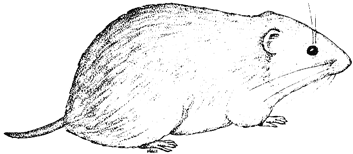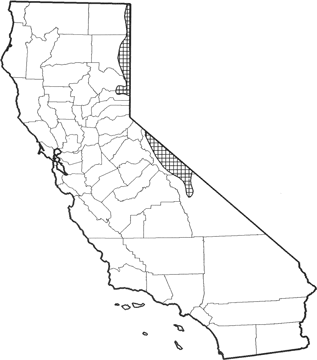
Sagebrush Vole
Distribution, Abundance, and Seasonality
In California, occurs in the Great Basin regions of northern Inyo Co., Mono Co., and the eastern parts of Sierra, Plumas, Lassen, and Modoc cos. Populations fluctuate, but generally are highest in sagebrush, bitterbrush, and low sage habitats. The sagebrush vole may be locally common to abundant in perennial grassland, pinyon-juniper, and alpine dwarf-shrub habitats. Found up to 3780 m (12,100 ft) in California (Dunmire 1961). Distribution is tied closely to sagebrush and perennial grassland (O'Farrell 1972).

Range Map
Specific Habitat Requirements
Feeding: This herbivore feeds on the flowers and leaves of virtually any available green plants. Food plants include a number of grasses, sagebrush, rabbitbrush, and a variety of forbs. In winter, sagebrush leaves and cambium are the most important foods. Sagebrush voles commonly forage under the canopy of shrubs and under grass cover. They also climb in shrubs to feed. May steal food from piles accumulated by other rodents.
Cover: Burrows are located in loose soil beneath shrubs. Each burrow has 20-30 entrances (James and Booth 1954). The depth of tunnels ranges from just beneath the surface to 56 cm (22 in) (Hall 1928, 1946), and nest chambers range from 9-25 cm (3.5-10 in) in diameter. Runway systems may be used, but usually are inconspicuous. During winter, these voles are active at the ground surface under the cover of snow.
Reproduction: Young are born in an underground nest chamber, in a nest of shredded sagebrush bark and grass stems (Moore 1943).
Water: Urine output is lower than in other microtines. Probably obtains water from food.
Pattern: These voles occur in habitats dominated by sagebrush, rabbitbrush, or bunch grasses, where the soil is loose and drainage is good (Carroll and Genoways 1980). Populations reach high levels after a combination of mild winter temperatures, higher than average summer precipitation, and early autumn rains. At low densities, sagebrush voles occur in isolated colonies.
Species Life History
Activity Patterns: Active yearlong. Mainly nocturnal, but active at any time of day. Daytime activity is highest in early morning and late afternoon. Strong winds reduce activity.
Seasonal Movements / Migration: None.
Home Range: No data found.
Territory: Sagebrush voles are social and may live in large colonies. Under laboratory conditions, males are agonistic toward nonreceptive females. The largest male probably dominates the colony. Females seldom fight, and they nest and suckle communally (James and Booth 1954).
Reproduction: May breed yearlong, but mostly from March to May and October to December. Summer sexual quiescence is particularly pronounced if summer precipitation is low. The gestation period is 25 days. An average of 5-6 young are born in each litter (range 1-13) (Carroll and Genoways 1980). Probably 2 or 3 litters per yr on average, but in captivity, may produce 6 litters in succession. Weaning occurs at 21 days. Both sexes probably breed after 60 days of age, although females may breed at 47 days (James and Booth 1954).
Niche: Owls probably are the most important predators (Carroll and Genoways 1980). Other predators include hawks, snakes, coyotes, bobcats, and badgers. At least 6 flea species are known from sagebrush voles, including 2 known plague vectors (Egoscue 1966, O'Farrell 1975). Sagebrush voles are the principal reservoir of sylvatic plague in Washington (Johnson et al. 1948).
Comments: Overgrazing and agriculture have eliminated this species from most of its original range (O'Farrell 1972). Abundance is irregular, so short-term surveys may not yield reliable distribution and abundance data.
Sources & References
California Department of Fish and Game, 1999.
California's Wildlife, Sacramento, CA.
Written by: P. Brylski, J. Harris, reviewed by: H. Shellhammer, edited by: R. Duke, S. Granholm
Bailey, V. 1900. A revision of the American voles of the genus Microtus. North Am. Fauna No. 17. 88pp. Carroll, L. E., and H. H. Genoways. 1980. Lagurus curataus. Mammal. Species No. 14. 6pp. Dunmire, W. W. 1961. Breeding season of three rodents on White Mountain, California. J. Mammal. 42:489-493. Egoscue, H. J. 1966. New and additional host-flea associations and distributional records of fleas from Utah. Great Basin Nat. 26:71-75. Hall, E. R. 1928. Notes of the life history of the sagebrush meadow mouse (Lagurus). J. Mammal. 9:201-204. Hall, E. R. 1946. Mammals of Nevada. Univ. California Press, Berkeley. 710pp. James, W. B., and E. S. Booth. 1954. Biology and life history of the sagebrush vole. Dep. Biol., Walla Walla Coll., Wash Publ. No. 4(rev.) 20pp. Johnson, D. H., M. D. Bryant, and A. H. Miller. 1948. Vertebrate animals of the Providence Mountains area of California. Univ. Calif. Zool. 48:221-375. Maser, C., and G. S. Strickler. 1978. The sage vole, Lagurus curtatus, as and inhabitant of subalpine sheep fescue, Festuca ovina, communities on Steens Mountain - an observation and intepretation. Northwest Sci. 52:276-284. Moore, A. W. 1943. Notes on the sage mouse in eastern Oregon. J. Mammal. 24:188-191. O'Farrell, T. P. 1972. Ecological distribution of sagebrush voles, Lagurus curtatus, in south- central Washington. J. Mammal. 53:632-636. O'Farrell, T. P. 1975. Small mammals, their parasites and pathologic lesions on the Arid Lands Ecology Reserve, Benton County, Washington. Am. Midl. Nat. 93:377-387.
California Animal Facts | California's Wildlife